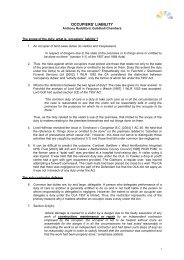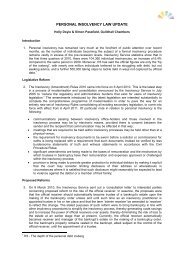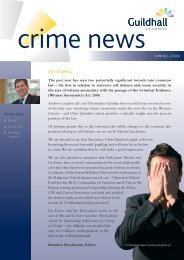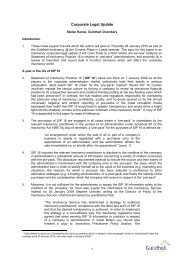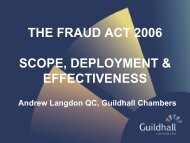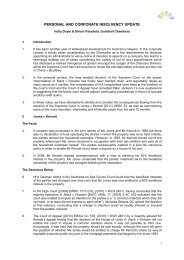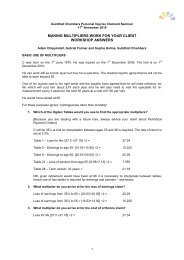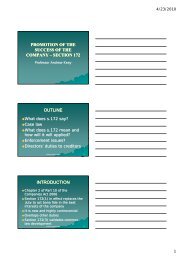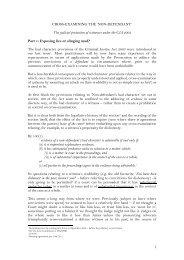Personal and Corporate Update - Holly Doyle & Simon Passfield
Personal and Corporate Update - Holly Doyle & Simon Passfield
Personal and Corporate Update - Holly Doyle & Simon Passfield
You also want an ePaper? Increase the reach of your titles
YUMPU automatically turns print PDFs into web optimized ePapers that Google loves.
7. In the recent appeal [2011] EWCA Civ 1286, [2012] BPIR 1286, the Court of Appeal has had theopportunity to provide further guidance in the matter.8. Patten LJ, giving the leading judgment (with which Ward <strong>and</strong> Moses LJJ agreed), identified fourtypes of liability which may be imposed on a guarantor by a guarantee of a loan:(1) An undertaking by the guarantor that the principal debtor will perform his own contractwith the creditor (a ‘see to it’ obligation);(2) A promise by the guarantor to pay the instalments of principal <strong>and</strong> interest which fall dueif the principal debtor fails to make those payments (a ‘conditional payment’ obligation);(3) An indemnity;(4) A concurrent liability with the debtor for what is due under the contract of loan.9. It was common ground that obligations in classes (2) <strong>and</strong> (4) create a liability in debt <strong>and</strong> thatobligations in class (3) are enforceable by way of action in unliquidated damages.10. The key issue before the court was whether an obligation in class (1) constituted a debt for aliquidated sum notwithst<strong>and</strong>ing that it creates a liability in damages (Moschi v Lep Air Services<strong>and</strong> Others [1973] AC 331), albeit one which is readily ascertainable by reference to the state ofaccount between the creditor <strong>and</strong> the principal debtor.11. Having conducted an exhaustive examination of the relevant authorities under previouslegislation including the Bankruptcy Acts 1849, 1861, 1869 <strong>and</strong> 1914, Patten LJ concluded that adebt for a liquidated sum must be a pre-ascertained liability under the agreement which givesrise to it (which can include a contractual claim for liquidated damages). For this reason,Premierpace was correctly decided on its facts.12. Turning to the application of the relevant principle to guarantees, the key issue is whether theliability of the guarantor can be treated as one which is reduced to <strong>and</strong> specified <strong>and</strong> agreed bythe guarantee itself. Since a ‘see to’ it obligation gives rise to a claim for unliquidated damages,although the measure of liability is the amount of the principal’s debt, that is not the same as anobligation to pay a sum of money under the contract whether as debt or agreed damages (whichdoes arise in relation to a conditional payment obligation).13. In the instant case, it was accepted that clause 2.4 of the guarantee amounted to an indemnitygiving rise to a claim for unliquidated damages <strong>and</strong> not a debt for a liquidated sum. However, itwas necessary to determine whether, on a proper analysis, clauses 2.2-2.3 <strong>and</strong>/or 4.2 imposedan additional obligation in classes (2) or (4), <strong>and</strong> hence a debt for a liquidated sum:Cl 2.2 Provided that the guarantor guaranteed all money <strong>and</strong> liabilities owing by the principaldebtor would be paid <strong>and</strong> satisfied when due;Cl 2.3 Provided that any amount claimed under the Guarantee was payable by the guarantorimmediately on dem<strong>and</strong> by the creditor.Cl 4.2 Provided that the guarantor’s obligations under the guarantor were those of principal <strong>and</strong>not just as surety. The creditor was not obliged to make dem<strong>and</strong> on, or take any stepsagainst, the principal debtor or any other person before enforcing the guarantee.14. Patten LJ concluded on balance that clause 2.2 gave rise to a conditional payment obligation onthe basis that:(1) The admitted damages obligation under clause 2.4 was stated to be a separateobligation <strong>and</strong> extended to any shortfall in the payment by the principal of the mortgagedebt, therefore overlapping with the liabilities covered by cl 2.2. Clause 2.4 would beunnecessary if the primary liability under cl 2.2 was simply a ‘see to it’ obligation;




